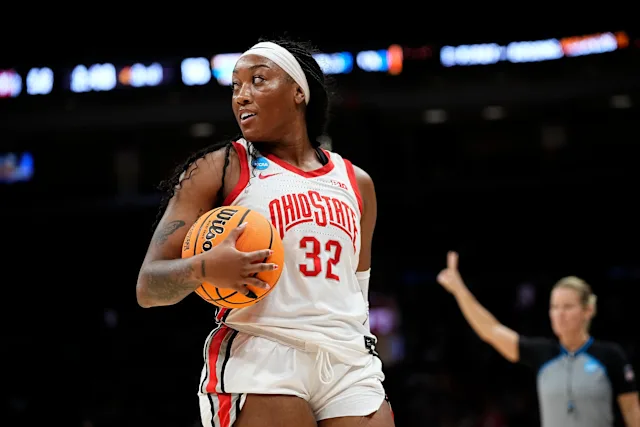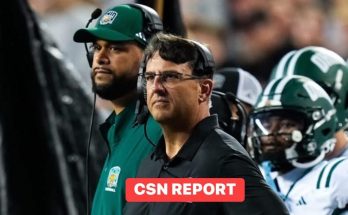Cotie McMahon’s decision to transfer from the Ohio State women’s basketball team sent shockwaves through the college basketball community, leaving many wondering what this departure says about the state of the Buckeyes’ program. McMahon, who had been a standout player for Ohio State during her time in Columbus, was expected to be one of the program’s cornerstone players for years to come. Her decision to leave raises important questions about the Buckeyes’ future, the culture of their basketball program, and the broader implications of the transfer portal era.
In this article, we will analyze McMahon’s departure from Ohio State, the potential reasons behind her decision, the impact it has on the Buckeyes’ basketball program, and what it means for the team moving forward.
Cotie McMahon: A Bright Future in Columbus
When Cotie McMahon arrived at Ohio State as a highly touted freshman in 2021, there was a great deal of excitement surrounding her potential. McMahon had been a standout high school player in the Midwest and was ranked as one of the top prospects in the nation. Her combination of size, athleticism, and basketball IQ made her a perfect fit for the Buckeyes’ fast-paced, up-tempo style of play.
Over her first two seasons at Ohio State, McMahon showcased her immense talent, earning significant playing time and becoming a key contributor on the team. In her freshman year, McMahon averaged 8.6 points per game, and by her sophomore season, she had expanded her role, contributing more across the board, including improving her rebounding and defense. Her athleticism, combined with her versatility as a wing player, made her a potential future star for the Buckeyes.
Despite the success McMahon experienced on the court, her transfer out of Ohio State in the spring of 2023 marks the end of what was expected to be a long and successful career with the program. The move has left fans, coaches, and analysts alike puzzled, as McMahon seemed to be a perfect fit for the team’s future plans.
Understanding the Transfer Portal and Player Movement
Before diving into the specific reasons behind McMahon’s transfer, it’s important to understand the broader context of the NCAA transfer portal and how it has shaped college basketball in recent years. The transfer portal, introduced in 2018, has fundamentally changed the way college athletes approach their careers. With the NCAA’s new rules allowing players to transfer without sitting out a season (if they have not previously transferred), the portal has created more player movement than ever before.
While the transfer portal offers athletes increased freedom to find the best fit for their skills, playing time, and future goals, it has also created uncertainty for programs. No longer are players tied to a program for four years, and the fluidity of rosters means that teams must continuously adapt to roster changes.
For coaches, the portal has become a double-edged sword. On one hand, it offers the opportunity to add talented players from other programs, which can instantly improve a team’s performance. On the other hand, it poses the risk of losing key contributors, often unexpectedly. Ohio State, like many other programs, has been affected by the transfer portal, both in terms of adding players and losing them. McMahon’s departure, however, stands out as one of the more significant losses for the Buckeyes.
Potential Reasons for McMahon’s Transfer
There is no definitive explanation for why McMahon chose to leave Ohio State, but several potential factors likely contributed to her decision. These factors are multifaceted and involve elements of player development, team dynamics, personal goals, and the changing landscape of college athletics.
1. Playing Time and Role on the Team
One of the most common reasons players transfer from programs is a desire for more playing time or a larger role. While McMahon was certainly a key contributor for Ohio State, it’s possible that she felt her future prospects at the program were limited. Ohio State, being one of the premier women’s basketball programs in the country, has a wealth of talent on its roster, and competition for playing time can be fierce.
With a loaded roster, McMahon may have felt that her opportunities to step into a larger leadership role or continue developing her game were constrained. As a highly skilled player, she likely wanted to be in a program where she could take on a more prominent role and receive more consistent minutes. If McMahon perceived that her future at Ohio State involved fighting for minutes with other star players, it’s possible that she sought a transfer to a program where she could have a more central role in the team’s success.
2. Coaching Staff and Program Culture
Another potential reason for McMahon’s departure could be a disconnect with the coaching staff or a difference in vision for her development. The relationship between a player and their coaching staff is crucial to a player’s success, and if McMahon felt that the coaching staff at Ohio State was not a good fit for her development or goals, it could have influenced her decision to leave.
Ohio State head coach Kevin McGuff has built a successful program, and his coaching staff has a strong track record of developing talent. However, like all programs, the team’s culture and coaching philosophy may not resonate with every player. McMahon may have felt that a different coaching staff or system would be a better fit for her talents and aspirations.
3. The Transfer Portal Era and Athlete Empowerment
It’s also important to recognize the broader trend of athlete empowerment in college sports. In the past, players often felt compelled to stick with the schools they initially committed to, even if things weren’t going according to plan. The transfer portal, however, has allowed players to take control of their own careers and seek out opportunities that align with their goals.
For McMahon, the decision to transfer may have been driven by a desire to find a program that could better support her individual goals, whether that involved a higher level of competition, a more prominent role on the team, or an opportunity to play in a different style of offense or defense. The transfer portal gives athletes more autonomy to shape their careers and seek out programs that offer the best opportunities for development and success.
4. Personal and Family Considerations
While not often discussed in the public eye, personal and family considerations can also play a significant role in a player’s decision to transfer. McMahon’s decision to leave Ohio State may have been influenced by factors such as her personal preferences, family support, or a desire to be closer to home. The decision to transfer is deeply personal, and it is possible that McMahon’s choice was influenced by non-basketball-related factors.
Impact on Ohio State’s Basketball Program
Cotie McMahon’s departure is a significant blow to Ohio State’s women’s basketball program. As one of the team’s most talented players, her loss leaves a gap in both talent and leadership that will be difficult to fill. McMahon’s ability to contribute on both ends of the floor, as well as her potential to be a future star, made her one of the cornerstones of the team’s future.
1. Depth and Talent Loss
McMahon’s departure leaves Ohio State with one less versatile and dynamic player on their roster. While the Buckeyes still have a strong roster, McMahon’s absence will be felt in terms of both scoring and overall team depth. The team will need to find ways to replace her scoring ability, particularly in the wing position, and continue to build around their remaining players.
2. The Recruiting Strategy
McMahon’s departure may also have an impact on Ohio State’s recruiting strategy moving forward. As a program, Ohio State has been able to consistently attract top-tier talent, and McMahon was a product of that recruiting success. However, with a high-profile transfer like McMahon, the program may need to adjust its recruiting approach to ensure that future players are committed to staying in the program and continuing to develop.
Recruiting will also need to focus on finding players who can fill the void left by McMahon’s departure. Ohio State’s coaching staff will likely look to the transfer portal themselves to add talent and depth, particularly at the wing position, and may also turn to their high school recruiting pipeline to secure the next generation of Buckeyes.
3. Cultural Implications
McMahon’s transfer may also have cultural implications for Ohio State’s basketball program. Transfers are not inherently a sign of a program’s decline, but a string of high-profile departures can lead to questions about the program’s culture, the player-coach relationship, and overall team dynamics. While Ohio State’s program under Kevin McGuff has had a great deal of success, McMahon’s exit could signal a need for adjustments in the way the team approaches player development and retention.
The Road Ahead for Ohio State
Despite McMahon’s departure, Ohio State remains one of the premier women’s basketball programs in the country. Head coach Kevin McGuff has built a successful program, and the Buckeyes still have a talented roster with players who can step up and fill the gaps left by McMahon. However, the program will need to adjust and adapt, both in terms of personnel and culture, to continue competing at a high level.
The Buckeyes will need to find a way to move forward without McMahon’s leadership and talent on the floor. The team will likely look to younger players to step up and fill the void, as well as explore new recruiting opportunities to bolster the roster. Additionally, McGuff and his staff may need to reevaluate how they manage player development and team dynamics to prevent further departures and maintain stability.



